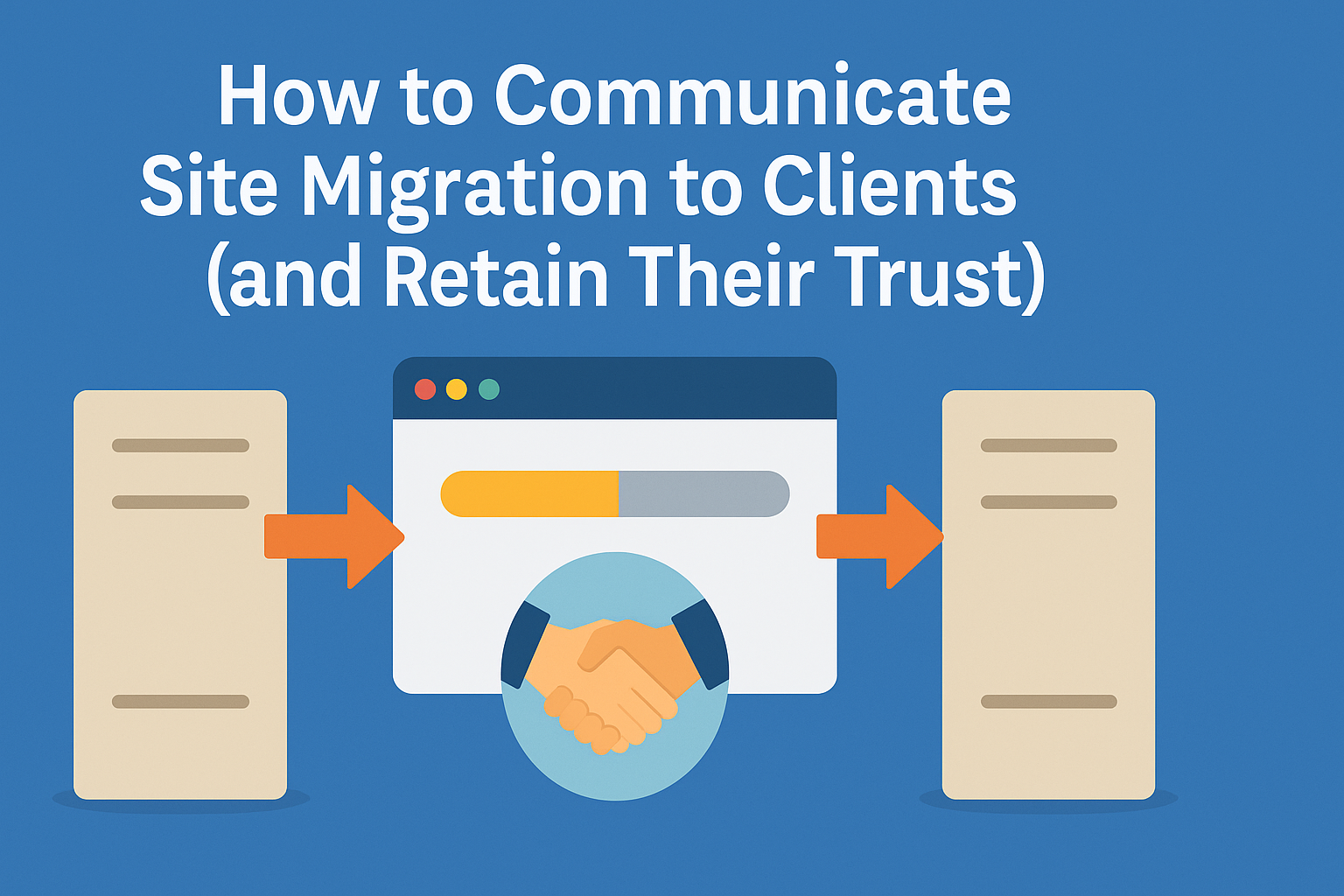Learn how to transparently and effectively communicate website migration plans to your clients—so you minimize surprises, preserve trust, and maintain alignment throughout the transition.
Introduction
Site migration can feel like a digital earthquake to clients—unexpected, confusing, and potentially damaging. Whether you're overhauling URLs, changing platforms, switching domains, or revamping structure, clients often fear one thing: losing traffic, visibility, or control.
But here’s the truth: it's not just about executing a smooth migration—it’s about communicating it clearly and confidently. When clients understand what’s happening, why, and how you’ll protect their interests, you earn their trust—and keep it.
This blog walks you through how to effectively communicate site migration to clients, reducing friction, maintaining transparency, and building long-term credibility.
1. Understand What Clients Fear in a Migration
Before crafting a communication plan, empathize with your clients. Their fears are real, and if unaddressed, they can lead to mistrust or panic.
Common concerns include:
- Loss of SEO rankings and organic traffic
- Website downtime or broken features
- A disrupted customer experience
- Lack of transparency during technical changes
Acknowledging these concerns early helps position you as a proactive and considerate partner.
2. Prepare a Client‑Friendly Migration Plan
Clients don’t need to see code—they need clarity.
Deliver a high-level, client-facing migration plan that includes:
- Why the migration is necessary (e.g., performance, SEO, security)
- A simple timeline: milestones, estimated dates, who’s responsible
- A list of anticipated risks and how you’ll mitigate them
- Tailored messaging: less technical, more business-focused
Bonus: Provide a one-page visual roadmap to keep it digestible.
3. Use Clear, Non‑Technical Language
Avoid overwhelming clients with tech jargon. Instead, simplify your language and provide analogies.
Examples:
- Instead of “301 redirects,” say: “We’ll ensure old pages automatically take visitors to the right new ones.”
- Instead of “indexing delays,” say: “Search engines might take a few days to catch up, which could briefly affect traffic.”
When in doubt, test your language on a non-technical person first.
4. Share Benefits & Reassure Stability
Communicating the value of the migration is as important as the process.
Highlight benefits:
- Faster load times
- Better mobile experience
- Enhanced security
- Long-term SEO gains
- Scalability for future growth
Also, reassure stability with pre-migration testing, a rollback plan, and real-time monitoring.
5. Create Communication Milestones & Checkpoints
Structure your client touchpoints just like your development sprints.
Suggested checkpoints:
- Kickoff Call – to explain strategy and gather concerns
- Pre-Launch Review – staging site walkthrough with client feedback
- Launch Notification – day-of communication and key contacts
- Post-Launch Check-In – initial review of traffic, performance, and issues
Proactive check-ins show you're in control and prevent clients from panicking over normal fluctuations.
6. Provide Client Visibility with Reports & Dashboards
Transparency builds trust.
Tools to share:
- Redirect maps (before/after page structures)
- QA reports (what was tested and passed)
- Real-time dashboards (GA4, Search Console)
- Visual comparisons of old vs new site metrics
Summarize in an executive-style format so even non-tech stakeholders stay informed.
7. Explain & Manage Short-Term Fluctuations
Even with a perfect migration, traffic might wobble.
Be upfront about:
- Potential temporary SEO drops
- Indexing delays
- Redirect caching issues
Explain these are normal and typically recover within a few weeks. This sets the right expectations and prevents misinterpretation of early data.
8. Support Through Launch & Post‑Migration Phase
The client journey doesn't end at the launch button.
Post-launch support should include:
- Uptime and crawl error monitoring
- Immediate bug fixes
- Continuous performance checks
- 30-day performance report
- Available point-of-contact for client concerns
Stay accessible and responsive during this phase to reinforce client confidence.
9. Use Communication Channels Strategically
Match your communication to your client’s preferred style and availability.
Options include:
- Email summaries and updates
- Slack or messaging tools for real-time concerns
- Weekly calls or reports
- Shared dashboards via tools like Trello, Asana, or Monday.com
Centralizing communication in one place helps keep things on track.
10. Learn & Iterate — Feedback Loop
After the migration dust settles, get feedback from your clients.
Ask:
- What part of the process felt clear or unclear?
- Did they feel informed at every stage?
- What could be improved next time?
Use this to improve future migrations and refine your communication process, turning lessons into long-term loyalty.
Conclusion
Migrating a website is a high-stakes operation—but it doesn’t have to shake your client relationships. By communicating clearly, managing expectations, and leading with transparency, you not only reduce anxiety but deepen client trust.
Remember: In the world of digital transformation, technical skill is expected. Clear communication? That’s your competitive edge.
FAQs
Will my SEO rankings be affected after migration? Possibly in the short term, but with proper redirects and planning, your rankings should recover and improve.
How long does recovery take? Usually between 2–8 weeks depending on the scale of the migration and how quickly search engines reindex your site.
Do I need to update my old links? Redirects handle most changes, but updating key external and internal links post-migration is highly recommended.
What if something breaks after the migration? Your provider should monitor and respond quickly. A post-migration support window should be part of your plan.
